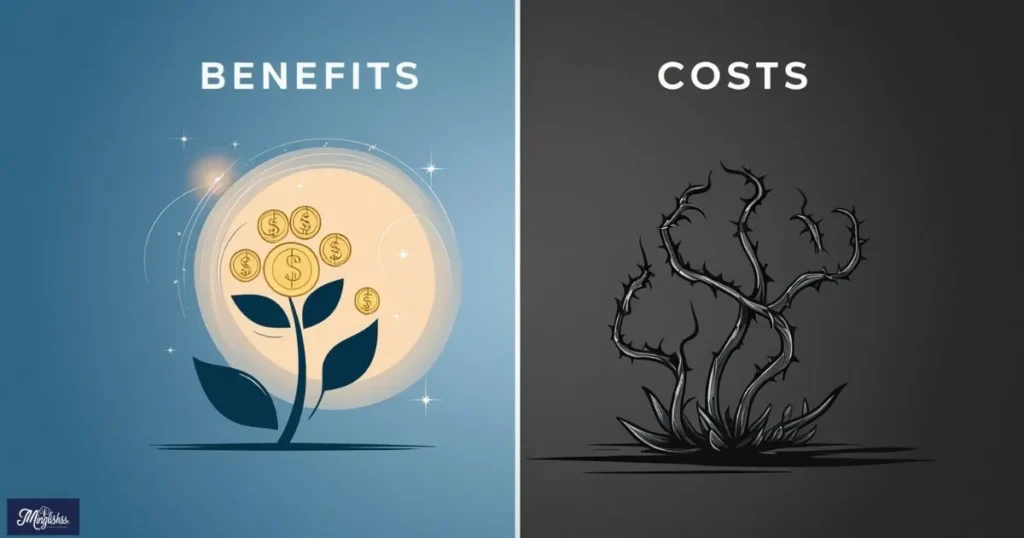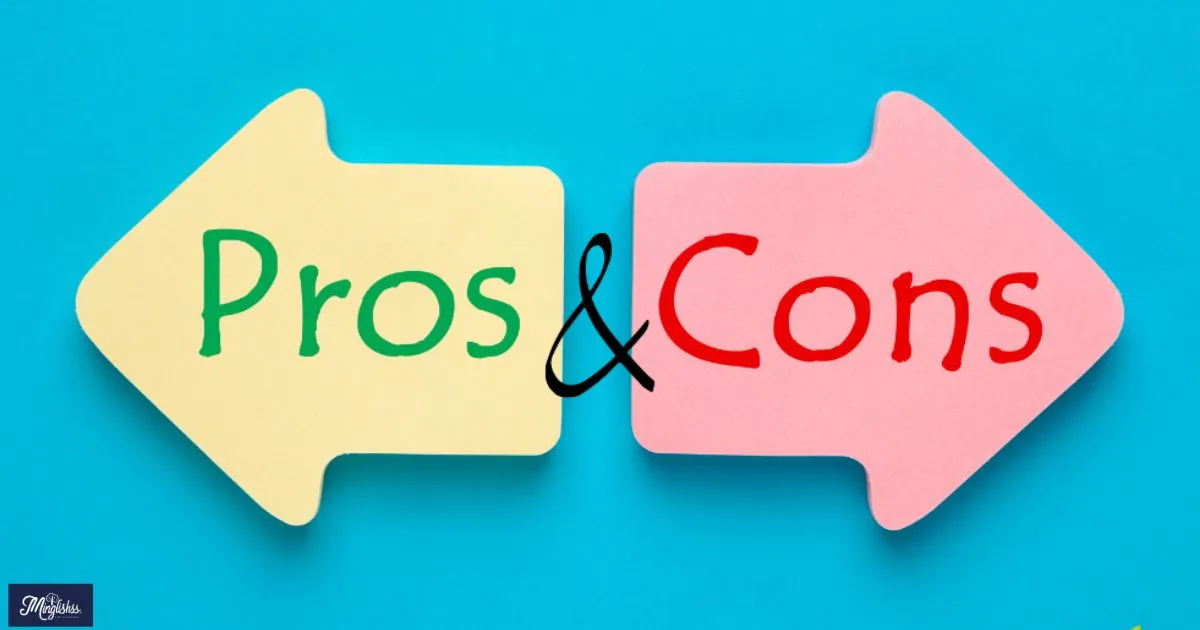“Understanding both sides of an issue is essential for informed decision-making.”
In any discussion or analysis, weighing the advantages and disadvantages is crucial. The term “pros and cons” is widely used, but there are many other ways to express this idea. Utilizing varied expressions can enhance your communication, making your points clearer and more engaging.
In this blog post, we’ll explore 35 alternative phrases for “pros and cons,” each accompanied by a scenario, an explanation, and additional tips. By incorporating these expressions into your conversations, you can foster a more nuanced understanding of the topics at hand.
1. Advantages and Disadvantages
Scenario: When evaluating a new policy at work.
Explanation: A straightforward way to present both sides of an argument.
Additional Tip: Use this in formal discussions to maintain clarity.
2. Benefits and Drawbacks
Scenario: When discussing a new software tool with your team.
Explanation: Highlights the positive aspects and potential issues.
Additional Tip: Be specific about each benefit and drawback for clarity.
3. Strengths and Weaknesses
Scenario: When assessing a candidate during an interview.
Explanation: Focuses on what a candidate excels at and areas for improvement.
Additional Tip: Encourage discussion on how weaknesses can be addressed.
4. Merits and Demerits

Scenario: When evaluating different investment options.
Explanation: A formal way to discuss the positive and negative aspects.
Additional Tip: Provide examples of each merit and demerit for context.
5. Upsides and Downsides
Scenario: When considering a job offer.
Explanation: A casual expression that highlights both sides.
Additional Tip: Discuss how the upsides might outweigh the downsides in your case.
6. Positives and Negatives
Scenario: In a group discussion about a project outcome.
Explanation: A simple way to convey both sides.
Additional Tip: List them out to make them visually clear.
7. Gains and Losses
Scenario: When analyzing a business decision.
Explanation: Focuses on what can be gained versus what might be lost.
Additional Tip: Use data to support your analysis of gains and losses.
8. Pros and Cons List
Scenario: When brainstorming for a personal decision.
Explanation: A direct way to refer to a written analysis of both sides.
Additional Tip: Keep it balanced to avoid bias in your decision-making.
9. Positive Aspects and Negative Aspects
Scenario: When evaluating a proposal.
Explanation: A formal approach to highlight both sides.
Additional Tip: Discuss how each aspect impacts the overall decision.
10. Trade-offs
Scenario: When deciding between two different options.
Explanation: Focuses on the compromises made when choosing one over the other.
Additional Tip: Discuss what is most important to you in the trade-off.
11. Considerations for and Against
Scenario: In a debate about a new law.
Explanation: A thorough way to outline arguments on both sides.
Additional Tip: Ensure each consideration is backed by evidence or reasoning.
Other Ways to Say “Thanks for Checking In”
12. Points in Favor and Points Against
Scenario: When discussing a community initiative.
Explanation: A clear way to present both arguments.
Additional Tip: Engage the audience by inviting their points.
13. Pros and Cons Analysis
Scenario: When making a strategic business decision.
Explanation: A structured approach to evaluating options.
Additional Tip: Use charts or graphs to visualize the analysis.
14. Favorable and Unfavorable Outcomes
Scenario: When discussing potential results of a project.
Explanation: Focuses on the possible results of decisions made.
Additional Tip: Assess which outcomes are more likely based on evidence.
15. Benefits and Costs

Scenario: When analyzing a new marketing strategy.
Explanation: Highlights the advantages versus the financial impact.
Additional Tip: Use specific figures to clarify the costs involved.
16. Plus Points and Minus Points
Scenario: When evaluating a friend’s suggestion.
Explanation: A casual, straightforward way to present both sides.
Additional Tip: Keep the tone light to encourage open dialogue.
17. Features and Drawbacks
Scenario: When reviewing a product.
Explanation: Focuses on what the product offers versus its limitations.
Additional Tip: Encourage users to share their experiences.
18. For and Against Arguments
Scenario: When preparing for a debate.
Explanation: A structured approach to understanding both perspectives.
Additional Tip: Make sure each argument is well-researched.
19. Assets and Liabilities
Scenario: When assessing a business’s financial situation.
Explanation: A financial term that can apply to various decisions.
Additional Tip: Provide context to what constitutes an asset or liability.
20. Plus and Minus
Scenario: When casually discussing a movie review.
Explanation: A simple and informal expression.
Additional Tip: Keep it brief to encourage a flowing conversation.
21. Rewards and Risks
Scenario: When considering a risky investment.
Explanation: Focuses on potential gains versus the risks involved.
Additional Tip: Assess how much risk is acceptable for the potential reward.
22. Positive Factors and Negative Factors
Scenario: When assessing the feasibility of a project.
Explanation: A detailed way to outline the components of a decision.
Additional Tip: Encourage team members to weigh in on each factor.
23. Gains and Trade-offs
Scenario: When discussing lifestyle changes.
Explanation: Focuses on the benefits versus what might be sacrificed.
Additional Tip: Discuss personal priorities to evaluate the trade-offs.
24. Advantages and Pitfalls
Scenario: When evaluating a new business strategy.
Explanation: Highlights both beneficial aspects and potential risks.
Additional Tip: Encourage open dialogue about how to mitigate pitfalls.
25. Gains and Sacrifices
Scenario: When discussing work-life balance.
Explanation: Focuses on what you gain versus what you give up.
Additional Tip: Discuss how to maximize gains while minimizing sacrifices.
26. Benefits and Issues

Scenario: When reviewing a team project.
Explanation: A straightforward way to discuss what went well and what didn’t.
Additional Tip: Use this as a basis for future improvement.
27. Good Points and Bad Points
Scenario: When discussing a friend’s idea.
Explanation: A casual way to present both sides.
Additional Tip: Keep the conversation constructive to encourage growth.
28. Bright Sides and Dark Sides
Scenario: When evaluating a new trend.
Explanation: A more metaphorical way to present the positives and negatives.
Additional Tip: Use real-life examples to illustrate each side.
29. Favorable and Adverse Conditions
Scenario: When discussing a project’s environment.
Explanation: A formal way to address external factors affecting decisions.
Additional Tip: Discuss how to leverage favorable conditions.
30. Pros and Cons Consideration
Scenario: When preparing for a significant life decision.
Explanation: A comprehensive approach to evaluating both sides.
Additional Tip: Take your time to reflect on each consideration.
31. Advantages and Shortcomings
Scenario: When assessing a policy change.
Explanation: Highlights the positives and the areas that need improvement.
Additional Tip: Discuss how to address the shortcomings.
32. Wins and Losses
Scenario: When analyzing a sports team’s season.
Explanation: A relatable way to highlight successes and failures.
Additional Tip: Use statistics to back up your analysis.
33. Opportunities and Threats
Scenario: When conducting a SWOT analysis.
Explanation: Focuses on potential gains versus external risks.
Additional Tip: Encourage team brainstorming to identify both.
34. Highs and Lows
Scenario: When reviewing a personal project.
Explanation: A casual expression that highlights both successes and challenges.
Additional Tip: Share personal anecdotes to illustrate each side.
35. Assets and Hindrances
Scenario: When evaluating a business proposal.
Explanation: A formal way to discuss the positive aspects and obstacles.
Additional Tip: Provide context for each asset and hindrance.
Pros and Cons of Using Alternative Expressions
Pros
- Enhances clarity by providing varied expressions.
- Encourages deeper understanding of the topic.
- Allows for a more engaging discussion.
Cons
- Some phrases may not fit every context.
- Misinterpretation can occur if the audience is unfamiliar with the terms.
Conclusion
Understanding the pros and cons of any situation is essential for making informed decisions. By using these 35 alternative phrases for “pros and cons,” you can communicate your thoughts more effectively and enrich discussions.
Remember, choosing the right expression can significantly impact how your message is received. Next time you need to evaluate something, consider trying one of these phrases to foster a balanced conversation!

Hi, I’m Lauren Reynolds: I bring creativity to English lessons, mixing fun with learning. My goal is to inspire students to explore and enjoy the language.










